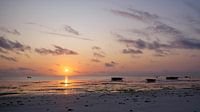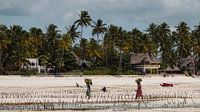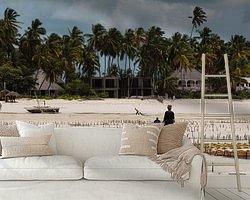Buy this landscape artwork seaweed farm by Willeke van Vulpen on canvas, ArtFrame, poster and wallpaper, printed on demand in high quality.
About "seaweed farm"
by Willeke van Vulpen
About the artwork
At low tide, residents of Jambiani ( Zanzibar ) grow seaweed. The women attach the seaweed to threads attached between sticks. This is early in the morning when it is low tide. With bales of seaweed on their heads, the women farmers go home.
Zanzibar's history has been influenced by Persians, Arabs, Muslims, the Portuguese, and inhabitants of mainland Africa. Stone Town, the historic city centre of the capital Zanzibar, is a district with winding avenues, round towers, carved doors, terraces and beautiful mosques. Architectural gems include the Livingstone House, the Guliani Bridge and the House of Wonders: a palace built in 1883 under Sultan Barghash.
Zanzibar is the world's third-largest producer of cloves (7%), but was once the world's largest producer.[1] Furthermore, Zanzibar exports spices, seaweed and raffia, and has a large fish and log canoe production.
Alongside this, tourism is also a major source of income. The island is also known for its diving spots in and around the coral reefs on Zanzibar's north and east coasts. Kite surfing is also on the rise, often to the dismay of fishermen and villagers.

About Willeke van Vulpen
Nature and Photography as a hobby. A golden combination. The calming effect of nature and being able to capture this on film provide many happy moments in my life. Being able to share this with people who can enjoy them completes the circle... Read more…
 Netherlands
Netherlands Ordered in February 2019
Ordered in February 2019
 Germany
Germany Ordered in January 2020
Ordered in January 2020
 Netherlands
Netherlands Ordered in November 2023
Ordered in November 2023
 Netherlands
Netherlands Ordered in February 2023
Ordered in February 2023
 Germany
Germany Ordered in November 2021
Ordered in November 2021
 Germany
Germany Ordered in August 2021
Ordered in August 2021
 Netherlands
Netherlands Ordered in February 2018
Ordered in February 2018
 Netherlands
Netherlands Ordered in June 2020
Ordered in June 2020
 Germany
Germany Ordered in August 2019
Ordered in August 2019
 Germany
Germany Ordered in May 2020
Ordered in May 2020
 Germany
Germany Ordered in August 2025
Ordered in August 2025
 Germany
Germany Ordered in August 2021
Ordered in August 2021
About the material
ArtFrame™
Interchangeable Art Prints
- High-quality print
- Easily interchangeable
- Acoustic function
- Large sizes available
Discover the artworks of Willeke van Vulpen
 In the evening sun.Willeke van Vulpen
In the evening sun.Willeke van Vulpen Lady Bird. with love.Willeke van Vulpen
Lady Bird. with love.Willeke van Vulpen Together we are strong.Willeke van Vulpen
Together we are strong.Willeke van Vulpen sunrise on Zanzibar.Willeke van Vulpen
sunrise on Zanzibar.Willeke van Vulpen Cheetah one with the landscape.Willeke van Vulpen
Cheetah one with the landscape.Willeke van Vulpen The world is waking up.Willeke van Vulpen
The world is waking up.Willeke van Vulpen Sunrise on Zanzibar.Willeke van Vulpen
Sunrise on Zanzibar.Willeke van Vulpen Working girl.Willeke van Vulpen
Working girl.Willeke van Vulpen Sunrise in pastel.Willeke van Vulpen
Sunrise in pastel.Willeke van Vulpen After hard work.Willeke van Vulpen
After hard work.Willeke van Vulpen The farmer at work on Zanzibar.Willeke van Vulpen
The farmer at work on Zanzibar.Willeke van Vulpen Lone heron.Willeke van Vulpen
Lone heron.Willeke van Vulpen Busy day at the beach.Willeke van Vulpen
Busy day at the beach.Willeke van Vulpen Zanzibar BleuWilleke van Vulpen
Zanzibar BleuWilleke van Vulpen seaweed farmersWilleke van Vulpen
seaweed farmersWilleke van Vulpen seaweed farmWilleke van Vulpen
seaweed farmWilleke van Vulpen Big family on tour.Willeke van Vulpen
Big family on tour.Willeke van Vulpen Little RobinWilleke van Vulpen
Little RobinWilleke van Vulpen purple skyWilleke van Vulpen
purple skyWilleke van Vulpen Golden forest.Willeke van Vulpen
Golden forest.Willeke van Vulpen













 Africa
Africa Beach
Beach Farm
Farm Landscapes
Landscapes Oceans and seas
Oceans and seas Photo wallpaper
Photo wallpaper Photography
Photography Serene Peace
Serene Peace Tanzania
Tanzania









